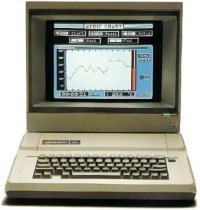Few inventions have changed the world so much as the microcomputer – certainly few have evolved as quickly, or have pushed forward as rapidly. These days, despite the incredible technology contained in them, computers have become something of an appliance. Granted its an appliance that the average home user faces with more frustration than most (your microwave is unlikely to get a virus, and your fridge probably doesn’t have its viewable area limited by those 18 toolbars you unwittingly installed) but they are common-place now. Most households with teenagers in them probably have more computer screens than TV screens these days.
 It’s easy, then, to think that they were always there. To forget the heady days of not 20 years ago when having a computer in your home meant you were on the cutting edge of technology. Or 30 years ago when getting computer lab time at your school meant something special. How even without Internet, those devices hooked up to a TV or crude monochrome contained within them undiscovered new worlds.
It’s easy, then, to think that they were always there. To forget the heady days of not 20 years ago when having a computer in your home meant you were on the cutting edge of technology. Or 30 years ago when getting computer lab time at your school meant something special. How even without Internet, those devices hooked up to a TV or crude monochrome contained within them undiscovered new worlds.
Most computer geeks of my generation can remember their first BASIC program – the first time our computer performed a novel action, at our own instruction. The first time we grasped the understanding that through this portal, our imaginations could be unleashed.
If you remember this, then you’ll understand the nostalgia that hit me in the face when I discovered that, not too far from my home, is a one-of-a-kind museum of classic computing. In a converted old opera house in Ontario hum 40 computers of yester-year. From the ubiquitous Commodore 64 and PCjr., to the rare and treasured IIgs Woz Edition and Apple LISA, from the Atari 800xl to the Amiga, and even a microcomputer without a keyboard and monitor — where input was entered on switches, and output returned on lights — these computers are all running, just like they did 15-35 years ago.
And they only represent a small fraction of the collection! Hundreds of other machines sit in storage, where they’re restored and rotated through the museum proper. A software library for each of these computers, original shipping boxes, magazines, instruction manuals, and advertising collateral have all been meticulously collected by a self-professed geek, and a team of volunteers.
The scope of this multi-decade project is more than impressive – it’s important. Few other collections like this exist in the world, and much of the history of modern computing – young though it may be – is at risk of disappearing into junk piles and garage sales until there is nothing left to mark the path we’ve followed to get here.
I read an article recently that said that NASA is having difficulty retrieving the data from the original moon missions – because the computers on which it was recorded no longer function. This isn’t recordings scratched into stone tablets centuries ago – this is information less than half-a-century old that we are loosing access to!
If you benefit from e-mail, or Skype, or a word processor or financial management software; if you’ve photoshopped a family picture, or dabbled in editing your home videos; if you’ve booked a vacation online, or surfed for recipes or home improvement tips then you owe it to the people who’s life’s work gave you these things – the inventors of the home computer, and the revolution that it brought to civilization – to check out the PC Museum, and donate a couple dollars to the preservation of the story of how we got here.
Take your kids, and let them press the keys of keyboards that sparked a generation of imagination and invention.




Ah yes, and who can forget the punch cards, fortran and backing up a computer with a video recording?